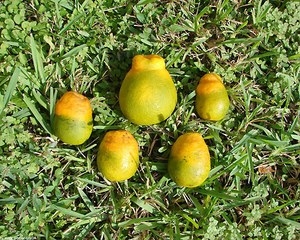Seven entities recently received $21.7 million to conduct research into combating and preventing HLB at the farm level. The funding is from the U.S. Department of Agriculture's National Institute of Food and Agriculture (USDA NIFA) Emergency Citrus Disease Research and Extension program.

(Photo by Tim Gottwald)
The University of Florida Institute of Food and Agricultural Sciences (UF/IFAS) received the majority of the funding, more than $16 million.
PROJECTS LED BY UF/IFAS
The largest grant, at approximately $8.6 million, is for development, evaluation and delivery of citrus HLB management approaches by targeting its nature as a pathogen-triggered immune disease. The principal investigator is Nian Wang. The goal is to develop HLB management approaches for existing groves and non-transgenic HLB-resistant and HLB-tolerant citrus varieties.
Other UF/IFAS projects are:
- A coordinated network for the improvement of HLB research and Extension outputs, funded at $2 million. Megan Dewdney is the principal investigator. The project tackles the task of gathering and organizing the research findings available to growers.
- Targeted production of non-transgenic HLB-tolerant trees through complementary approaches, funded at approximately $1.5 million. Zhonglin Mou is the principal investigator. The first goal of this project is to produce non-genetically modified HLB-tolerant citrus trees by editing or silencing the promising target genes.
- HLB-resistant rootstock candidates for the citrus industry: Validating and understanding disease resistance, funded at approximately $1.2 million. The principal investigator is John Chater. This project will advance knowledge about why some rootstocks appear to be more tolerant to HLB than others.
- Providing individual protective covers and brassinosteroids to prolong health and improve fruit yield and quality in newly planted trees, funded at $800,000. Fernando Alferez is the principal investigator.
- Toward a reliable insect cell culture-based technique for culturing CLas bacteria (the causative agent of HLB), funded at approximately $793,000. Kirsten Pelz-Stelinski is the principal investigator. The project aims to have a culture system that serves as an essential research tool for increased understanding of CLas biology and for effective, rapid screening of antimicrobial agents against CLas.
- Accelerating the delivery of conventionally developed HLB-tolerant citrus scions and rootstocks as pathogen-free budlines for replicate multi-site testing, funded at approximately $536,000. The principal investigator is Jude Grosser. Successful adoption of this technology will reduce the current clean-up time by 1.5 to 2 years, and significantly increase the number of selections that can be processed.
PROJECTS LED BY OTHER INSTITUTIONS
- Virus-induced gene silencing using insect specific viruses to manipulate psyllids as a strategy to control HLB is a University of California-Davis project led by Yen-Wen Kuo.
- A method for generating an optimally attractive scent for Asian citrus psyllid biocontrol is a University of Connecticut project led by Alexander Aksenov. UF/IFAS' Lukasz Stelinski is a co-investigator.
- Endophytes as sources of antimicrobials to control HLB is being led by Kateel Shetty of Florida International University.
- Scalable low-cost organic nanocarriers for efficient foliar uptake of registered anti-HLB agents is a Purdue University project led by Kurt Ristroph.
- Citrus yellow vein-associated virus induced gene silencing vector for vaccinating seedlings and controlling HLB in infected fruit-bearing trees is a University of Maryland project led by Anne Simon.
- Molecular strategies to block psyllid transmission of the HLB pathogen is a USDA Agricultural Research Service project led by Michelle Heck.
Sources: USDA NIFA and UF/IFAS
Deformed HLB-infected fruit
